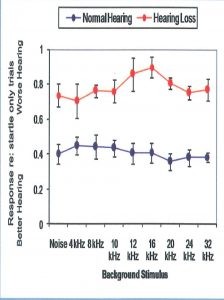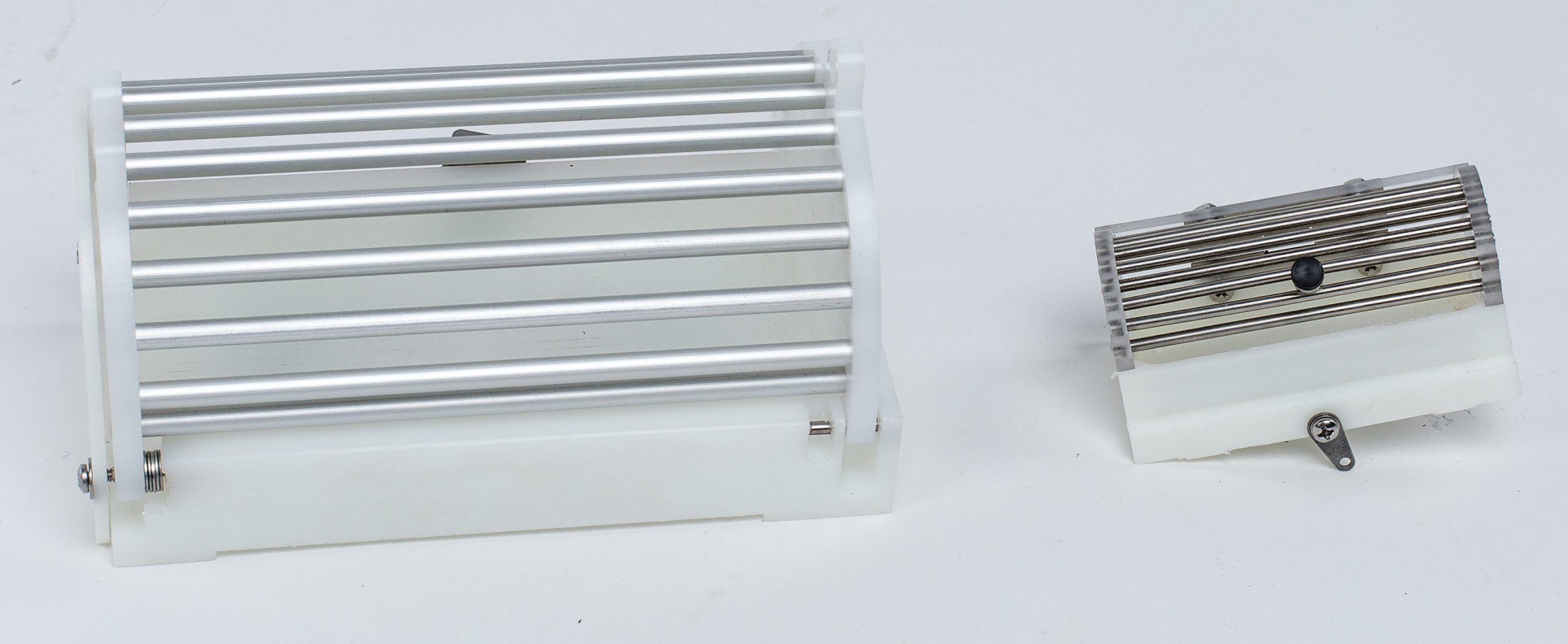Startle
Our new Hearing Loss and Tinnitus options for our StartleMonitor system, featuring our patent pending OtoCentrix technology, have been specifically designed for rodent applications in our StartleMonitor system. Through the use of pre-pulse inhibition and gap detection you will be able to measure hearing loss at frequency or perform studies in the field of tinnitus research. These new options are the result of a 20 year pursuit of advancing startle. StartleMonitor systems using these options have become a key component of basic tinnitus research and toxicology tests for determining hearing loss in rats and mice.
As the chart to the right shows, when an animal is exposed to a large stimulus in normal background noise, the animal startles in response to the stimulus. If, prior to the large stimulus, there is a gap in the background noise slightly before the large stimulus, the response to the subsequent large stimulus is greatly diminished. However, the gap has to be significant. If the “gap” is just a slight dimunition of the background noise, this “gap” won’t produce the diminished startled response of the full-blown gap. In a variant of this, if instead of having a constant background noise with a gap before the large stimulus, you have essentially silence with a pre-pulse slightly before the large stimulus, you will also get a greatly diminished response to the subsequent large stimulus.

As Young & Fechter said in their landmark 1983 paper titled Reflex inhibition procedures for animal audiometry (J. Acoust. Soc. Am., 73, 1686-93)*:
“By manipulating both the frequency and intensity of the prepulse stimulus, it is possible to probe with different stimuli to determine which sounds the animal can or cannot hear.”
In summary, as shown in the graph below, if the animal can hear the pre-pulse probe stimulus, the startle is inhibited. So, if the animal’s startle response is muted, it means the animal heard the sound. If the animal’s startle response is NOT muted, it means the animal DID NOT hear the sound.

Ototoxicity
Kinder Scientific’s StartleMonitor system allows you to systematically probe the animal’s hearing by eliciting and measuring the animal’s startle response!
Drugs, Chemicals and Disease known to cause ototoxicity:
Medical conditions known to cause ototoxicity:
- In utero exposure to viruses:
-
- cytomegalovirus
-
- herpes
-
- toxoplasmosis
-
- rubella
-
- syphilis
- Measles, chicken pox
- Bacterial meningitis (leading cause of acquired deafness in infants and children)
- High bilirubin levels
- High Fever
- Chronic ear infection
- Tumors, stroke, head trauma
Chemicals known to cause ototoxicity:
Exposure to some chemicals alone causes hearing loss independent of noise exposure, while some chemicals have additive or synergistic effects with noise exposure at the workplace, in military or home settings.
- Fuels (gasoline, diesel, kerosene, jet fuel)
- Carbon monoxide
- Lead and derivatives
- Toluene
- Xylene
- Styrene
- Pesticides
- Cyanide, arsenic, paraquat
- Tricholoroethylene
- Dichloromethane
Drugs known to cause ototoxicity:
- Non-Steroidal Anti-Inflammatory Drugs (NSAIDS) such as aspirin, methyl salicylates (e.g., BenGay), Ibuprofen, naproxen
- Antibiotics (aminoglycosides like kanamycin, neomycin, gentamycin as well as erythromycins, vancomycins and many others
- Diuretics such as furosemide and bumetanide
- Chemotherapeutic (cancer) agents such as bleomycine, cisplatin, carboplatinum and methotrexate
- Antimalarials such as chloroquine phosphate and sulfate
- Cardiac medications such as propranolol, quinidine
- Anesthetics such as lidocaine, bupivacaine
- Pyschopharmacological agents such as amitryptiline, benzodiazepines like diazepam and midazolam, bupropion, fluoxetine, imipramine and lithium
- Glucocorticoids such as prednisolone
*References:
- Bauer, C.A., Brozoski, T.J., Boley, J. & Wyder, M. (1999). Behavioral model of chronic tinnitus in rats. Otolaryngol. Head Neck Surg., 121, 457-462
- Bauer, C.A. & Brozoski, T.J. (2001) Assessing tinnitus and prospective tinnitus therapeutics using a psycho-physical animal model. J. Assoc. Res. Otolaryngol., 2, 54-64
- Turner, Brozoski, Bauer, Paarrish, Myers & Caspary (2006). Gap detection deficits in rats with tinnitus: A potential novel screening tool. Behav. Neurosci. 120, 188-195
- Young, J.S. & Fechter, L.D. (1983). Reflex inhibition procedures for animal audiometry. J. Acoust. Soc. Am., 73, 1686-93
Key Features:
Superior Sound Attenuation!
Our cabinets set the industry high mark with 10 dB greater attenuation factor over all other systems! This critical characteristic is one of the primary reasons our system is capable of sound pressure control at 57 dB. In the past, the background sound levels used in classic publications has been 70 dB. This has not been because scientists did not want to use lower values but because the attenuation was insufficient to allow it. With Kinder Scientific’s startle reflex cabinets, you can use much lower sound pressures for background.Superior Acoustic Design to minimize variability
Startle research has long had the reputation for high subject to subject variability. Acoustic startle responses are tied directly to the accuracy of the noise stimulus and the quality of the ambient noise control. We designed our system with a high precision circuit providing +/- 1 db accuracy at all points of the scale (57-120 db) and +/- 2 db accuracy from chamber to chamber!35 decibels of attenuation!
Our cabinets have the highest sound attenuation available on the market. The closest competition provides only 22-25 db. Recall that decibels are a logarithmic scale with 10 decibels representing an increase or decrease in amplitude of about three times. So, an additional 10 db of attenuation means our startle chambers are about three times as quiet as our competitors! Obviously, three times attenuation is very significant!No acoustic calibration or strange tables to create or use.
Simple and direct! Because our our attenuation is so high, you are able to use noise levels down to 57 db! You will no longer be limited to 65 db as a lower limit. (The reason most publications report 65 or 70 db as a background is NOT because the science prefers that level; it is because that is all the attenuation all systems but ours can produce!) And our system is factory calibrated so all you need do is enter the desired db level. No calibration tables are needed for each station nor do you use an arbitrary number table as with some systems; you simply enter the level you want and that’s it!A Simple Windows based system.
This simple system architecture ultimately means less effort for you during startup! Simply connect a single cable from our Behavior System Core (BSC) to your PC and you’re ready to go! To add stations, just connect one cable to your computer and one to each additional station you buy. We’ve eliminated the ‘rats nest’ of cables typically needed for all the signals!
Open Rat Restrainer 
Closed Rat and Mouse Restrainers Unique restraint design
Our unique design removes stress on the animal induced by older tube methods. Older systems place animals into tubes that have long been known to create stress in the animals. Our unique restraint design holds the animal consistently over the sensing transducer while still providing the animal an ample sensation of freedom of movement. The key design feature is the open ceiling that allows the animal increased headroom while preserving the animal’s feeling of constraint and safety all without permitting ambulations. In addition, the unique design facilitates optogenetic and microdialysis tethers!!Calibrated in Newtons, not arbitrary units!
We were the first in the industry to use a load cell to measure the test animal’s startle response. Using a load cell allows us to measure and determine the animal response in milliNewtons. Now you can be confident when comparing your studies; there is no longer a concern over what the system was originally set to or how your data compares to other data. Additionally, the stability of the system is high enough to reduce the number of times you have to check the calibration.Compact cabinet to help save your lab space.
We realize how hard it is to come by lab space! So, we made a special effort to design our cabinet to be the smallest available. You can place almost twice as many cabinets in the same space as our closest competitor and still have a system that outperforms them all!Higher throughput with less cleaning time!
We paid close attenuation to the comments of experienced technicians and researchers who suffered for years with cleaning problems. Active labs reported spending over 1 full hour each day just for cleaning for large systems. We designed a unique bathtub design for the restrainers to gather and contain waste. For cleaning, you simply remove the restrainer, open it and rinse it out under running water and you ready to proceed with the next session.Easy to use Windows based software.
We model our Startle Monitor software after our popular MotorMonitor program, with concise yet flexible input screens. As a result, we have a single input screen from which you will do almost all of your work:. input session parameters, order your trial lists, input subject information, edit trials, edit sessions and run any desired session you choose!Stable Platform.
The overall cabinet design contains sufficient mass for a stable platform. With a weight of over 70 pounds, the assembly creates significant stationary inertia.Quiet Fan.
Our specially designed fan circuit uses a “quick start” voltage to get the fan started and then scale back to produce the proper ventilation with minimum fan noise. Slower fan speed = less noise.Hardware Specifications:
Acoustic Performance
● Full spectrum White Noise: -35 dB +/- 1 dB
● Chamber to Chamber variation: +/- 1 dB
● Cabinet Isolation +/- 2 dBResponse Performance:
● Load Cell Sensing Assembly Calibrated and Reported in Newtons +/- 2% full scaleControl Circuitry & Software:
● Independent Control Chassis (no pc card to install)
● Simple ethernet or RS232 Serial communication
● Station connection – via a single parallel cable
● Windows 7 Pro or Windows 10 Pro PlatformPhysical characteristics:
● Compact Cabinet Design 14″ (35.56 cm) wide x 10.875″ (27.62 cm) deep by 19.5″ (49.53 cm) high
● Weight: 35 lbs (15.88 kg)
● Cabinet built from High Quality Laminate and MDF
Animal Restrainers:
● Easy-to-use restrainers
● Stress free design (no tubes)Ordering Information:
BSC-100 – Behavioral System Core
SM1000-II – Startle II Station
SM2001LC – Rat Startle Load Cell Restrainer
SM2001LCL – Large Rat Startle Load Cell Restrainer
SM2002LC – Mouse Startle Load Cell Restrainer
SM2004LC – Juvenile Rat Startle Load Cell Restrainer
SMG-M-II – Startle II Mouse Grid
SMG-R-II – Startle II Rat Grid
SMTAC – Startle Tactile Option
DSCK – Dual Output Scramble ShockerSMSPL – Startle Monitor Sound Pressure Meter
SMLP – High Intensity LED Option for Startle
Coming Soon….
